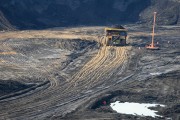As a second wave of oiled ducks created outrage about the consequences of oilsands tailings lakes, another oilsands story broke last week that impacts far greater numbers of waterfowl.
On Friday, Alberta Environment Minister Rob Renner announced that the Alberta government is not planning to implement the recommendations of the Alberta Water Council.
In the absence of a long overdue provincial policy, wetlands continue to be lost in the forested regions of Alberta with no requirement for mitigation or compensation. And according to Renner's announcement last week, that's not about to change.
Back in January of this year we blogged about our concerns that oilsands development would be allowed to destroy 200,000 hectares of wetlands in the coming decades if the Alberta government didn't implement a strong wetland policy for the province. The recommendations from a three-year process by the Alberta Water Council were already on the table to allow the government (which participated in creating the recommendations) to put in place a policy that supported the viewpoints of 23 sectors (of 25 who participated), and had the support of the public (90 per cent of public respondents surveyed supported the recommendations put forward by the Council).
 Yet years after the policy was promised by the Alberta government, we all waited anxiously for news of what the policy would look like. We were sorely disappointed when the intent of the new policy was announced last week. This announcement further erodes public trust in government's ability to manage oilsands impacts at a time when Albertans and the international community are seeking leadership. With outcomes such as this, Albertans would be right to question the amount of time and resources we put into participating in the government's multistakeholder processes.
Yet years after the policy was promised by the Alberta government, we all waited anxiously for news of what the policy would look like. We were sorely disappointed when the intent of the new policy was announced last week. This announcement further erodes public trust in government's ability to manage oilsands impacts at a time when Albertans and the international community are seeking leadership. With outcomes such as this, Albertans would be right to question the amount of time and resources we put into participating in the government's multistakeholder processes.
One of the central recommendations of the Water Council was the concept of no net loss of wetlands. Under that type of policy, if a wetland is destroyed, it must be replaced elsewhere. There are many wetland areas in Alberta that require restoration, given that we have already lost up to two-thirds of our wetlands in the settled portions of the province. No-net-loss policies for wetlands are a standard policy tool used in the U.S.
If Albertans have resoundingly signalled that they think protecting Alberta's wetlands is both desirable and achievable, why is the government backsliding?
The oilsands industry said it would be too expensive — which is the main reason for the letters of non-consensus from the two oilsands stakeholders that participated in drafting the no-net-loss wetland policy recommendations. When asked for numbers, the government stated it took the industry statement at face value. No one has yet been able to contest numbers produced by the Alberta Wilderness Association, which show that this type of no-net-loss compensation could be completed for a mere 50 cents per barrel of oil produced from the oilsands.
It remains to be seen whether the provincial government will continue with its "wetland policy intent," a complicated policy intention characterized by further delays and no concrete outcomes. The three-year Alberta Water Council process presented a practical suite of recommendations to meaningfully address the environmental impacts of oilsands development. At a time when 83 per cent of Alberta's business leaders polled by Alberta Venture magazine think that "Alberta's business interests have been damaged by our global reputation on environmental stewardship," it's clear that pandering to the oilsands industry has economic as well as environmental repercussions.









